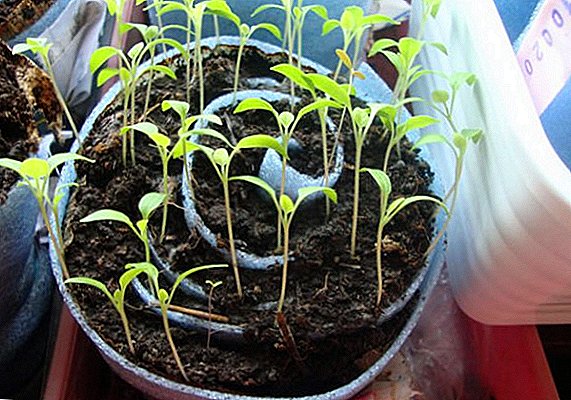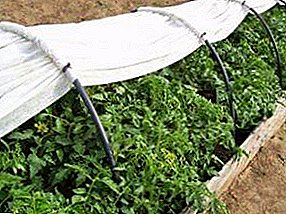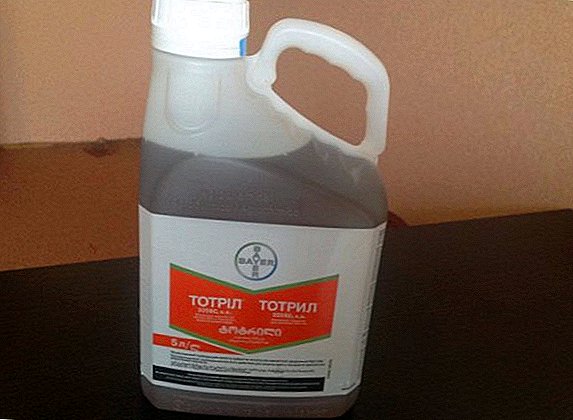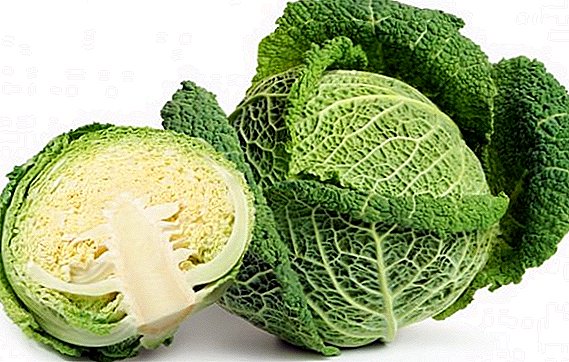 Many of our tourists who have been abroad (in Europe, the USA, Canada) note that cabbage in local restaurants and taverns (in various dishes, salads and cakes) is softer, more aromatic and tastier than ours. The point here is not the skill of the cooks, but the fact that they prefer Savoy cabbage here. Unfortunately, savoy cabbage is not so popular here, although its benefits are so great that it deserves the title of “queen of vegetables”.
Many of our tourists who have been abroad (in Europe, the USA, Canada) note that cabbage in local restaurants and taverns (in various dishes, salads and cakes) is softer, more aromatic and tastier than ours. The point here is not the skill of the cooks, but the fact that they prefer Savoy cabbage here. Unfortunately, savoy cabbage is not so popular here, although its benefits are so great that it deserves the title of “queen of vegetables”.
Did you know? The type of cabbage, which was first bred in the small Italian Duchy of Savoy in the 17th century, was called "Savoy". In Italy, this cabbage is called Milanese, Lombardian (Savoy entered Lombardy). Czechs and Poles call it French (in the 19th century. Savoie became part of France). The French king Louis XIV loved her very much, he even granted a noble title with a coat of arms (three cabbages of cabbage with two crossed shovels) to the royal gardener. Every year in the city of Udine, Italians celebrate the holiday "sagra" - in honor of the Savoy cabbage, where you can taste dozens of dishes from it.
Savoy cabbage: calories, vitamins and minerals
For those who do not know what Savoy cabbage looks like, it should be said that outwardly it is very similar to its sister - the usual white one. But there are differences:
- head is loose, has a loose structure;
- leaves are soft, delicate and embossed (coarse fibers are absent);
- color - rich green.
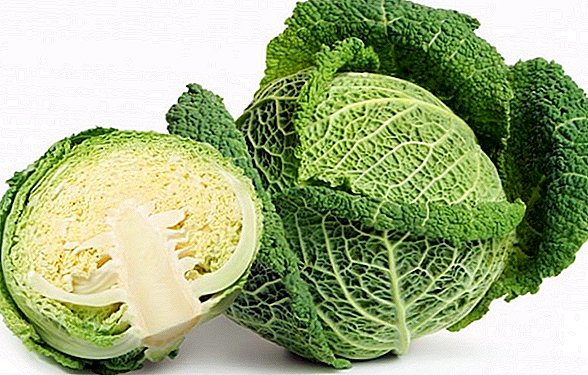
- vitamins (thiamine, ascorbic, folic, pantothenic acid, tocopherol, niacin, riboflavin, pyridoxine, methionine, phylloquinone, beta carotene);
- minerals (iron, calcium, magnesium, zinc, potassium, sulfur, phosphorus, fluorine, iodine, copper, boron, aluminum, manganese, cobalt, etc.);
- pectin;
- protein;
- cellulose, etc .;
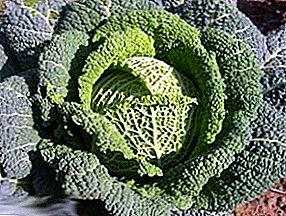
Did you know? In Russia, savoy cabbage appeared in the 19th century. The reason for its low popularity is often referred to as unsuitability for fermentation (although this is only partly true - you can marinate this cabbage). Savoy cabbage unpretentious: it is cold-resistant (does not freeze at -14 WITH), it grows on soils with a high salt content (from the 17th century in Holland it was used for desalination of the soil).
What is useful Savoy cabbage for the human body
The beneficial properties of savoy cabbage and easy absorption by the body are due to its unique composition:
- indispensable in the treatment of avitaminosis, increase immunity, to maintain good tonus (thanks to a balanced vitamin complex);
- improves motility of the gastrointestinal tract, prevents gastrointestinal disorders (due to the content of pectin and fiber);
- normalizes blood pressure, prevents the development of cardiovascular pathologies (contains potassium and magnesium);
- replenishes mineral reserves of the body;
- inhibits the development of malignant and benign tumors, prolongs youth (due to the natural antioxidant glutathione, ascorbigen, sinigrin, etc.);
- stabilizes the nervous system;
- has a beneficial effect on vision and intraocular pressure;
- improves appetite and metabolic processes;
- regulates cholesterol levels, improves metabolism and removes "bad" cholesterol (tartronic acid);
- has a stabilizing effect on blood sugar levels;
- cleans the liver of toxins (due to manganese);
- provides the body with easily absorbed calcium and vitamin D (especially important for the child's body).

Important! The only cabbage that contains mannitol sugar alcohol (used as a sweetener) is Savoy. This property is especially useful for diabetics.
How to choose the savoy cabbage when buying
Buying savoy cabbage, you should follow simple rules:
- cabbages of savoy cabbage should not be tight - they should be close at hand when pressed;
- choose the cabbages of the correct round shape;
- leaves must be flawless (damage, rot, etc.), be evenly green (depending on the variety - light or dark). White or yellow shades, brownish specks, cobweb, white bloom are unacceptable (signs of cabbage pests).
Did you know? The origin of the word "cabbage" is derived from the Latin word "caputum" - "head" (among the Celts, the word "cap" also meant the head). The origin of the plant itself is covered in mystery. For the right to be called the birthplace of this super-useful vegetable claim Georgia, Spain, Italy and Greece.
How best to store savoy cabbage
 When buying several heads of savoy cabbage or in the case when after cooking a portion of the head remains, the question arises how to keep it fresh for some time. It should be borne in mind that Savoy cabbage is more delicate than white cabbage, and this has a negative effect on its storage - it loses moisture faster.
When buying several heads of savoy cabbage or in the case when after cooking a portion of the head remains, the question arises how to keep it fresh for some time. It should be borne in mind that Savoy cabbage is more delicate than white cabbage, and this has a negative effect on its storage - it loses moisture faster.
Cabbage should be put in a plastic bag or wrapped with cling film and placed in the vegetable compartment of the refrigerator. So it will retain its freshness for 3-4 days.
If it comes to whether the Savoy cabbage is suitable for storage, whether it should be left for the winter or not, the opinion is expressed that it is not stored for a long time. This is not quite true. Cabbage, bought in a supermarket, will be difficult to save until spring. The reason is that it all depends on its variety. You will not always be able to determine which sort it is.
 Early varieties of savoy cabbage are not suitable for preservation, no matter what conditions you create for them. For long-term storage (from 4 to 6 months), middle-late and late varieties (“Uralochka”, “Ovasa F1”, “Valentina”, “Lacemaker”, etc.) are suitable, which are distinguished by darker shades of green.
Early varieties of savoy cabbage are not suitable for preservation, no matter what conditions you create for them. For long-term storage (from 4 to 6 months), middle-late and late varieties (“Uralochka”, “Ovasa F1”, “Valentina”, “Lacemaker”, etc.) are suitable, which are distinguished by darker shades of green.
By growing your own savoy cabbage, you will be able to regulate yourself what variety to plant. For proper storage of cabbage, you must:
- Do not water it on the eve of collection, cut off in dry, cool weather;
- select whole heads of cabbage (0.5 kg) without rot and dry;
- trim the stalk (no more than 3 cm);
- optimal conditions for storage: in a dark room at a temperature of 0 to +3 ° C at 90% humidity (basement cellar);
- the way of storage (in wooden boxes, in a suspended state or "pyramid") does not matter. The main thing is that there should be a distance of several centimeters between the heads of cabbages.
Important! Savoy cabbage can be dried for the winter. Drying (at a temperature of 50-60 ° C) allows you to save all the vitamins and minerals. Cabbage, thinly chopped, dried in a single layer in an electric dryer or oven (with conversion). Dried cabbage will change its color to grayish or yellowish (it will become light when cooked). Properly dried cabbage can retain its properties for up to two years.
What to cook from savoy cabbage
What can be cooked from savoy cabbage? In principle, all that is usually prepared from white. Savoy cabbage has a stronger taste and aroma. The methods of its preparation are somewhat different from the traditional ones: Savoy cabbage is tender, leaves are thinner and lack coarse streaks. It is easy to digest, causing the taste to spoil, and nutrients will be lost. A few general rules of cooking:
- cooking time (boiling, stewing) should be reduced by 5-10 minutes (compared to white cabbage);
- when roasting, it absorbs oil strongly, in salads it is dressing and sauces (it is important not to overdo it);
- before frying, its leaves are recommended to blanch (lower for 3-4 minutes in boiling water) and allow to drain;
- after cutting the cabbage, hold it for 4-5 minutes (this will improve its taste).
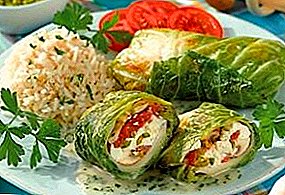
Speaking about the popular methods of cooking Savoy cabbage, it is necessary to note its fresh use in salads. The number of only Italian traditional recipes of such salads is two dozen.
One of them is with avocado, pepper and shrimp. For the salad, two pieces of Bulgarian pepper, 200 g of tomatoes, 400 g of savoy cabbage, eight tiger shrimps (boiled), soy sauce, salt, olive oil, rosemary are required. Shrimp pickle in sauce. Soak rosemary in oil. Cut cabbage and vegetables, mix everything, pour over oil, add shrimps.
The taste of savoy cabbage is enhanced and underlined by spices (anise, basil, marjoram, ginger, balsamic vinegar, juniper, etc.). Cabbage goes well with red fish, sour cream, tomatoes and cucumbers.
Important! To provide the body with vitamins, minerals and other essential substances, it is enough to include Savoy cabbage in your menu twice a week (use at least 200 g).
 The Savoy cabbage recipes are striking in their diversity - they are stewed, fried, baked, they are made into burgers, schnitzels, pies, etc. One of the most popular dishes is cabbage rolls with pork and beef, baked in the oven.
The Savoy cabbage recipes are striking in their diversity - they are stewed, fried, baked, they are made into burgers, schnitzels, pies, etc. One of the most popular dishes is cabbage rolls with pork and beef, baked in the oven.
For one head of cabbage you will need: minced beef and pork (250 g each), broth, onions (2 pieces), carrots (2 pieces), three celery stalks, olive oil, black pepper, oregano, salt. Cooking process:
- Rinse the cabbage, disassemble the leaves;
- prepare vegetables (cut onion into eight pieces and cut into petals, celery and carrots cut into large pieces);
- heat the oil in a frying pan and fry the vegetable cuttings for 5 minutes;
- blanch the leaves, put in a container with ice water. Lay out to dry;
- finely chop the non-conditum leaves, the second onion. Fry in olive oil;
- mix roast, thyme and oregano with minced meat;
- wrap the stuffing (tablespoon) in cabbage leaves and form stuffed cabbage rolls (fold them into an envelope);
- put the vegetable roasting in a heat-resistant container, put cabbage rolls, pour broth, close with foil;
- Preheat oven to 180 degrees and bake for 15-20 minutes.
 Schnitzels from savoy cabbage are very popular. The cooking process is simple: boil cabbage leaves in milk, roll, dip in a mixture of beaten egg and ground walnuts and fry.
Schnitzels from savoy cabbage are very popular. The cooking process is simple: boil cabbage leaves in milk, roll, dip in a mixture of beaten egg and ground walnuts and fry.
Puff pastry recipe: puff yeast dough (2 packs), raw egg (for lubrication), cabbage, leek, four hard-boiled eggs, bay leaf, 100 ml of white dry wine, salt. To prepare the dish you need:
- defrost the dough;
- prepare the filling (cut the head into pieces and place in boiling water, add salt and bay leaf. Shred the onion and cabbage, chop the eggs. Fry the onion, pour in wine and stew for 10 minutes. Mix with cabbage and eggs);
- roll out and cut the dough into squares. Fold out the filling;
- pinch the edges of the dough squares, place on a baking sheet and brush with an egg;
- bake for 15-20 minutes until cooked at medium temperature.

Contraindications to the use
Savoy cabbage, despite the fact that the benefits of its use are well known, can be harmful. First of all, it is about eating fresh, but sometimes you have to give up stewed or fried cabbage. You should be careful about the consumption of this product or to exclude it from the diet of people:
- in the postoperative period (the area of the abdominal cavity and the chest organs);
- suffering from pancreatitis, gastritis, with peptic ulcer exacerbations;
- with abnormalities of the endocrine system (thyroid gland);
- with urolithiasis.
Did you know? The popular version that children “find” in cabbage came to us from Flanders and France.








